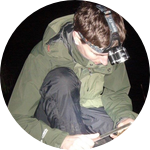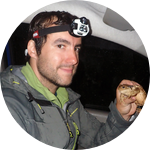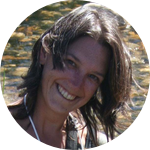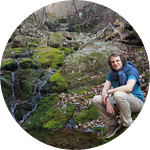About This Project
Invasive apple snails (Pomacea spp.) may negatively impact aquatic species in Cambodia. Using citizen science via the free software iNaturalist, we will quantify the co-occurrence of apple snails with native frogs and toads which are commercially important food species and include endangered species. Analysis of resulting records combined with existing data on e.g. land use, will provide information critical for protecting these species and to raise the profile of invasives research in Cambodia
Ask the Scientists
Join The DiscussionWhat is the context of this research?
When asked if I had heard any bullfrogs (Kaloula pulchra) this year, I realised I hadn’t, and also that I had seen less tadpoles than usual. Consultation with an amphibian expert friend (Amaël Borzée) produced several hypotheses, which was narrowed down to one following a big rainfall when all the areas I used to see tadpoles were full of apple snails. Apple snails are environmental pests in their wide invasive range and Golden apple snails (Pomacea canaliculata) are on the IUCN “100 worst invasives” list. A literature search showed that apple snails may impact frogs and toads by predating their eggs and ingested snail eggs may harm frogs. Interactions with apple snails may help explain anuran population declines but little is known so far. So we decided to investigate…..
What is the significance of this project?
Invasive apple snails are a global problem, impacting aquatic animals through predation and competition and altering aquatic ecosystems and plant communities. They are also major pests for rice crops. In Cambodia, rice is a major industry, and frogs are commercially important foods. If apple snail populations are increasing and they are impacting frog populations, as observations suggest, this may be devastating for Cambodian ecology and food production, but to date very little is known about apple snail distribution or impacts here. Globally, amphibians are already under threat from the amphibian plague, so an additional threat may spell the end for many populations. Finally, this project will raise the profile of invasion research and build capacity in science education in Cambodia.
What are the goals of the project?
We will launch this project at the Cambodia STEM festival in January 2021. The event is virtual this year and the organizers are hoping for 50,000 visitors, so this will maximize our exposure. At the same time we will find an MSc student.
In February, we will design our education pack and our student will start visiting groups who signed up during the festival to explain the use of iNaturalist. Visits will take 4 months.
Entries to iNaturalist will be monitored throughout and in December a final count will be taken. These data will be combined with land use and ecological data in statistical analyses to assess impacts on anurans from apple snails, agriculture and habitat alteration. We will submit a paper for publication and the student will graduate in early 2022.
Budget
This project will be (mostly) carried out by a graduate student. Student bursaries in Cambodia are very limited so here at the University of Battambang our Masters programs run on the weekends so that students are able to work during the week. The student bursary will enable our research student to be paid while working on their thesis project and so focus on their studies.
The travel and subsistence budget will enable our student to visit student (and other) groups to explain our project and demonstrate how to use iNaturalist. As STEM subjects have previously been overlooked in Cambodia, this will also serve to encourage people to become involved in science.
Knowledge of invasive species impacts and aquatic ecology is limited in Cambodia, so we will produce an educational package on aquatic ecology and invasive species in general and our study species in particular to be distributed during the above visits, so raising the profile of invasive species research.
Endorsed by
 Project Timeline
Project Timeline
January 2021: Set up an iNaturalist page; launch project at the Cambodia STEM festival (Jan 25-29). Interview/recruit a student.
February 2021: Design and produce the education pack
February-May 2021: Visit student (and other) groups to explain the project and the use of iNaturalist
February-December 2021: Monitor iNaturalist
December 2021-January 2022: Conduct statistical analyses
January-March 2022: Prepare student thesis and write paper
March 2022: Submit paper
Dec 03, 2020
Project Launched
Jan 15, 2021
Set up dedicated iNaturalist page
Jan 25, 2021
Launch the project
Jan 31, 2021
Interview and recruit student
Feb 15, 2021
Production of education pack
Meet the Team
Affiliates
Affiliates
Kit Magellan
My name is Kit Magellan and I am the only Research Professor at the University of Battambang in Cambodia (and probably the only one in Cambodia). I obtained my PhD at the University of St Andrews in Scotland, followed by academic positions at Rhodes University (South Africa), the University of Girona (Spain) and The University of Hong Kong (Hong Kong SAR). My publications can be found at: https://scholar.google.com/scholar?hl=en&as_sdt=0%2C5&q=Kit+Magellan&oq=k
I have been studying aquatic ecology for 18 years and invasion ecology for 10 years. While my main model species are fish, in particular the ubiquitous mosquitofish, I am fascinated by all ecology and especially the interactions between invasive and native species. My tenure as an Associate Editor and then Editor in Chief of the international peer reviewed journal, Aquatic Invasions (https://www.reabic.net/journals/ai/About.aspx), together with my global research experience, has provided a solid grounding and wide knowledge base for aquatic invasions.
OK, all of the above sounds great, but it’s a bit dry hey. Why am I here and why do I want to do this project? I am passionate about science and I believe everyone has a right to education. I also strongly believe that the scientific world lacks diversity and may overlook important research because of where it is done. I came to Cambodia to promote science and to try to address this bias. This project is an unexpected step towards this goal. This is classic science – observation of a phenomenon, research to get background and formulate hypotheses, then collection and analysis of data to test those hypotheses. I am enjoying the thrill of discovery and I want to bring this same thrill to people here and to demonstrate that good ecological research can come from a developing country. Overall, this will be challenging, but the biggest challenges bring the greatest rewards!
Amaël Borzée
I am a professor at Nanjing Forestry University, and my principal research interest is behavioural ecology and wildlife conservation. My scientific education started in western Europe and I obtained a PhD from Korea, before doing a post-doc at Ewha W. University in Seoul and then moving to China to start my lab. You can find my scientific profile here.
My original focus is on understanding the reasons behind the amphibian decline, the links with their behavioural ecology, and how plan conservation plans through research. I am now however shifting towards the breeding behaviour and conservation of species in East Asia. My primary experience was with treefrogs in Korea, but I now wish to address broader questions aimed at the conservation of multi-species populations over large landscapes, including multiple types of approaches and analytical tools.
My past research experience, education and other academic activities such as conference attended an grant accessed can be found here. I routinely use citizen science for my research, and I was able to determine the range of several species and the impact of climate change on their range based on data collected through citizen science platforms such as iNaturalist. My experience with invasive species is generally linked to amphibians as well, and especially American bullfrogs and the diseases they carry; but also to the impact of invasive slugs feeding on amphibian eggs when parents guarding the eggs don't recognise the invasive slugs as threats.
In addition I am also a secretariat member of the IUCN SSC Amphibian Specialist Group, the communication officer for the International Herpetological Committee, and a board member and chapter liaison for the Society for Conservation Biology, Asia section.
Additional Information
Citizen Science has not yet been attempted in Cambodia. Education in Cambodia is still quite limited with many people (especially girls) having to leave school to support their family by age 12. Science subjects in particular have been overlooked until recently. I hope to use this project to encourage people from all walks of life to become engaged in science and to think about ecology, and so promote science education and the conservation of Cambodian (aquatic) ecosystems.
Project Backers
- 25Backers
- 47%Funded
- $2,650Total Donations
- $106.00Average Donation




